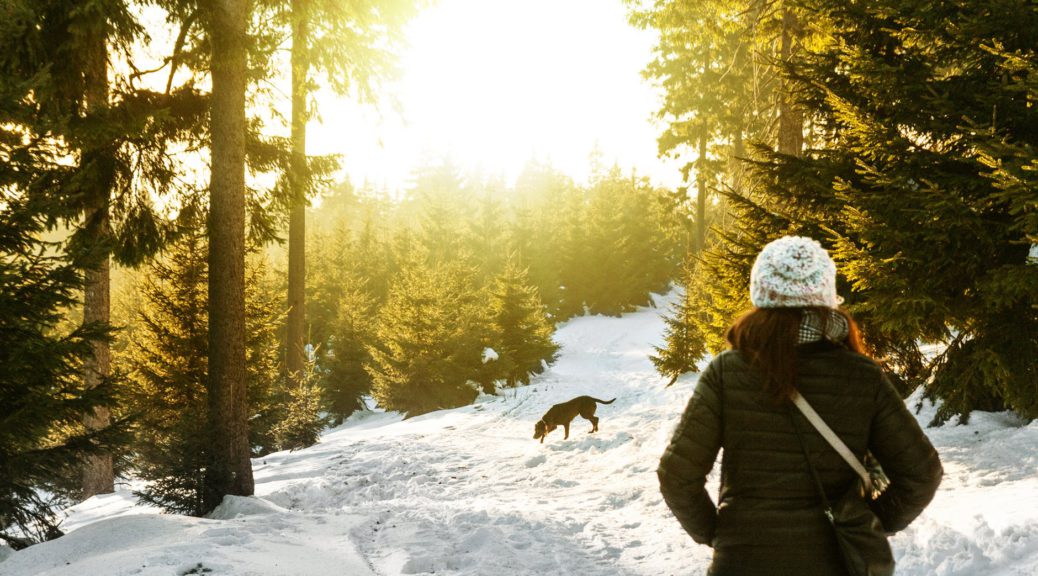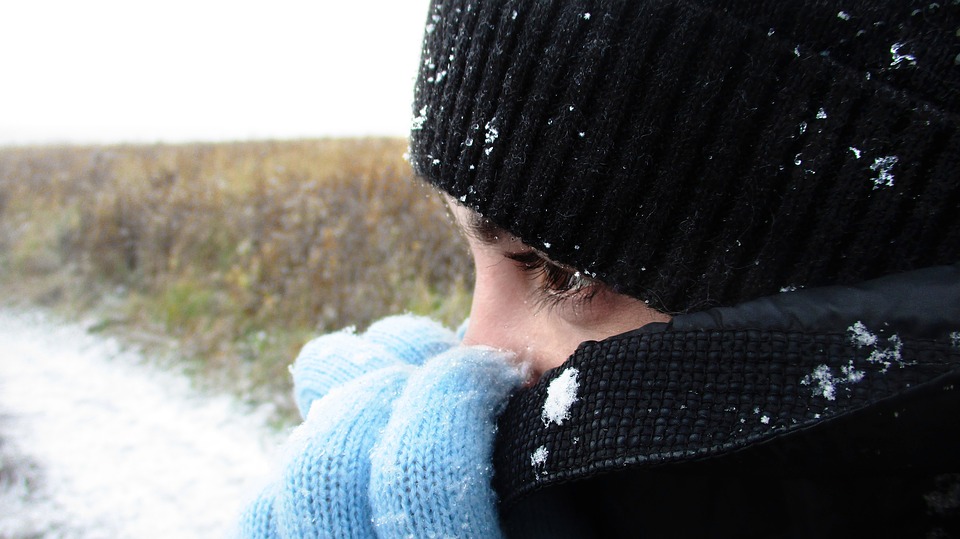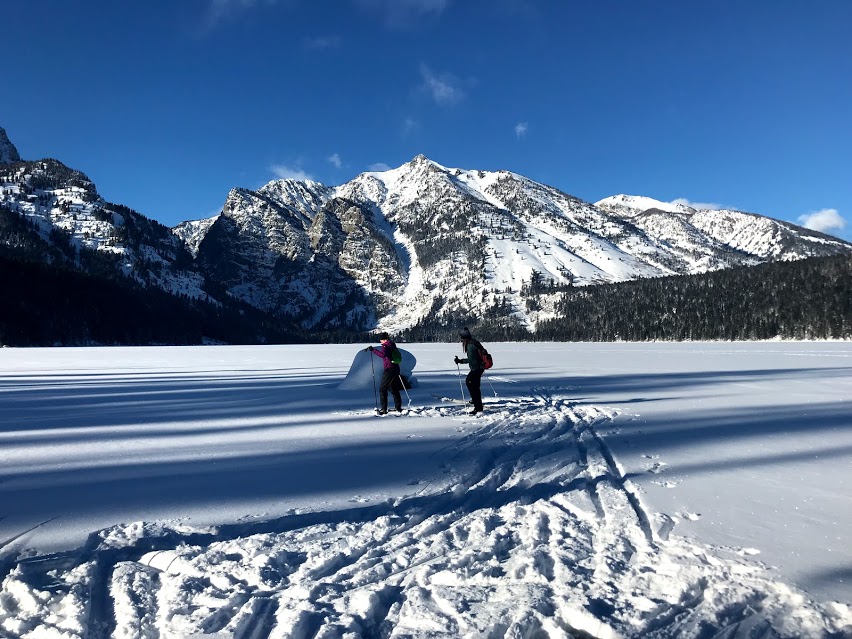
Snow Hiking Equipment – What to Bring on Your Winter Adventure
So you’ve decided you want to go snow hiking. You want to experience the wonder of the natural world in winter. As with any extreme environmental situation, it is very important to be prepared for the conditions that you will face. In this post we are going to discuss the snow hiking equipment you should have on hand when you’re out there adventuring this winter.
This post will focus on winter day trips. If you are planning on heading out on a multi-day hike or winter camping trip you will need to have additional gear on top of the equipment discussed in this article.
Adequate layers
Layering. Layering. Layering. If you’re new to the outdoor scene you may not yet understand the importance of this word, but you soon will. Layering is perhaps the most important aspect of snow hiking equipment. Layering is the key to staying safe and comfortable in winter environments.
==> For a complete breakdown of good layering techniques for any situation click here <==
So what layers should you bring? Of course, it depends on probable conditions. The more extreme the conditions, the more important the layers. I often adventure in areas where winter high’s tend to hover right around 10º F. I’m sure I don’t need to tell you that this is very cold!
In addition to my base layer I usually wear a polyester pullover, an insulated down jacket, a waterproof shell and snow pants. I also wear 1 or even 2 hats, a neck warmer that I can pull up over my face, a good pair of wool socks, and a thin pair of gloves inside thicker waterproof gloves.

It is important to think about your most vulnerable body parts, namely fingers, toes and the tip of your nose. These body parts are vulnerable because they are small, isolated bits of you that don’t get to share in the collective heat that the larger parts of your body generates.
Everyone is different so adjust your clothing to fit your needs. If your feet get cold easily you may want to wear a thicker pair, or even 2 pairs, of socks. But be careful not to restrict blood flow to your feet by wearing too thick socks shoved into too small boots.
If you’re prone to chilly fingers, consider trying mittens instead of gloves. This will keep your fingers closer together so they aren’t individually isolated. A hand warmer or two slipped inside the mitten can also work wonders!
Keep your nose warm with a scarf, neck warmer, or balaclava.
Be careful of cotton
You may have heard the phrase, “cotton kills.” And it’s true, cotton can be dangerous. This is because cotton is not very good at releasing moisture into the air. When cotton gets wet, it’ll stay wet. This is bad news in the winter because wet means cold.
When you are snow hiking you will likely still sweat even when it’s cold. If you’re wearing cotton, the sweat from your body will soak into the clothing and it won’t go away, this can make you very cold! This is also true of any other material with poor wicking properties.
Instead, wear clothing made from synthetics like nylon, or fibers with natural wicking properties such as merino wool.
Consider your traction needs
Trail conditions will determine whether you can hike simply in your boots or if you need some extra traction to help you along. Good winter hiking boots should already give you a fair amount of traction. If you’re only hiking trails of moderately compacted snow you will be just fine.
However, when the trail gets icy, or the snow-pack gets very firm, your boots may no longer be up to the challenge. This is when you might need a bit of extra help to keep going.
The first line of defense against slippery trails are donning some micro-spikes. Micro-spikes attach to your boot and dig into the snow or ice so that you can gain the traction you need. They are good for fairly level trails.
When the trail gets steeper you may need to move to phase two, crampons. Crampons are the micro-spikes big brother. They are longer and sharper and can help you gain traction on those very slippery, steep slopes.
If you don’t feel like gearing up with either of these traction devices, don’t worry, you can find tons of winter hikes where you won’t need them. Just be aware that they do exist, and could help you hike to that hard to reach frozen waterfall you’ve wanted to visit.
What about snowshoes or skis?
When the trail is covered in fresh powder or the snow is very deep, you won’t want to head out with just your boots. If you do, you will quickly exhaust yourself as you sink waist deep with every step!
Snowshoes are perfect for powder. This piece of gear spreads your weight out onto the larger surface area of the snowshoe which prevents you from sinking deep into the snow!
Cross country skis will also help you remain on top of the snow. There are tons of different styles of skis, too many to go into depth with this post, but you can find skis geared toward off-trail travel as well as skis that are meant to be used on groomed or packed trails. If you rent skis from an outfitter, they will most likely be the latter. Either way, skis are a great way to cover ground when hoofing it just won’t cut it.

Food and Water!
Don’t think you won’t need as much water just because it isn’t hot. You will still sweat as you exert yourself on the trail and you need to replenish those fluids! Staying hydrated helps you retain your body heat. When you’re dehydrated, your vulnerable body parts that we discussed earlier will be at an even higher risk of frostbite.
Remember that water can and does freeze! It does no good to you if you need a drink only to find your water bottle is frozen solid. Keeping your water in a main pocket of your pack instead of an external pocket will help it stay warmer. You can also take along an insulated water bottle which will keep your water temperature constant all day.
Same goes for food. Food is your bodies fuel, you directly convert that fuel into heat energy. Hungry and cold is a recipe for disaster. So pack a lunch and bring some extra snacks. You can even eat something spicy to give yourself a boost of extra warmth!
Weather protection
When I think of sun screen, I think of hot summer days at the beach. I’ll admit that I often forget that sun screen is just as important in the winter time. On clear winter days the sun has a double plan of attack. It shines down from the sky, and it’s UV rays reflect off the snow from below. So don’t forget to lotion it up!
Along those same lines, the snow can be blinding. I never leave the house without a pair of sunglasses.
Protect yourself from wind with chapstick and good windproof layers. (Yes I said it again.) The wind can cut right through your insulation if you don’t wear a good windbreaker. If it’s waterproof, it’s probably a great wind-resistant layer as well.
If the conditions are wet, sleety or slushy you would do well to have a waterproof pack, or a waterproof cover, to keep the contents nice and dry.
Don’t forget the 10 essentials
I am a big advocate of bringing emergency supplies with you every single time you enter the backcountry, whether it be a day hike or a multi-day trip. So, in addition to all the previously mentioned items, don’t forget the ten essentials!
==> Click here to learn all about the 10 essentials <==
I’m a fan of the saying, There’s no such thing as bad weather, only bad gear. With the right gear, the weather and the cold is no match for you! So don’t let it get in the way of your adventure plans this winter.
I hope you found this article useful and I hope you get out there, stay safe, and have a great time in the good ol’ outdoors!
If you have any questions, concerns or suggestions of something you would add to this list, please reach out in the comments below!
15 thoughts on “Snow Hiking Equipment – What to Bring on Your Winter Adventure”
I have never gone snow hiking before although lately I have been thinking of embarking on it. But I don’t know the essential things I really need to take along when I haven’t done it before. So after getting informed and educated through this article I think I’m ready to give it a try.Thanks.
Best of luck Lok! I hope you have a great, snowy adventure.
Thanks for the great post! I totally agree with the whole layer thing. Sadly, I seem to always wear cotton and I’ll have to make a few adjustments for my next trip.
Do you happen to have a post or information on what to bring for your pet? I ask this because I have a Border Collie and a Jack Russell that I’d love to take to the snow but I’m concerned about their well being as too. Do you have gear recommendations for them? I’ll be honest, I didn’t consider this until I saw your picture with the dog in the snow. but they love to go on trips and a trip to the snow might be exciting for them.
What are your thoughts on the chemical heat packs to stay warm?
Thanks again, I’m off to take a look at your 10 essentials.
Hi Scott!
When I take my dog snow hiking I usually have her wear dog boots to protect her feet from ice balling up between her toes. Click here for some specific boot recommendations. If it’s quite cold, you may also consider getting your dog a sweater or jacket.
I’m a fan of hand warmers for sure. Anything that can save you from frostbitten fingertips is ok in my book.
Hey Mariah,
I’ve really enjoyed reading this article as it’s interesting and informative. I’ve paid a visit to the Swiss Alps a few days back and it was really very cold in there. I ruined it for myself cause I didn’t carry the right clothing for the trip. You do need two hats for sure as it can be pretty cold in other countries as well. After reading this article, I’m pretty sure that I’ll be preparing well in advance for my next hiking adventure.
Thank you for taking your precious time in writing this blog post. Keep up the good work Mariah!
Hi there! Preparation can really make a world of a difference!
What an excellent article! You have been so thorough that I find your information quite adequate to prepare me for a winter outing. I also thought your 10 essentials list was very valuable. These are great suggestions and tips for anyone wanting an outdoor winter adventure. Thanks for posting it.
Thanks Fran! If you enjoyed this article why not check out 5 Reasons Snow Hiking Can Change Your Life.
Been thinking about getting out in the winter outdoors and found your article very informative. Lots to consider in order to have an enjoyable (and safe) experience. Like avoid cotton clothing is something I would not have thought of and to have ample water. Do you have any recommendations for an affordable suitable clothing retailer (online store)? Thanks.
If you’re ok with buying used items there are a lot of affordable options. I personally find a lot of great outerwear at thrift stores. Remember that brand names don’t matter as much as material type and quality.
REI also has an outlet where you can find name brands at up to 50%. These can still be pretty expensive though (but everyone’s definition of affordable is different so it can’t hurt for you to check them out.)
This is great advice for travelling on foot in the snow when hiking.
The last thing I want to be is cold. It might have bothered me as much when I was a kid but now that I am a lot older the cold goes right through me.
I have to be covered up but my feet are the most important because they are always cold so I need very thick socks!I can’t agree with you more about layers! When you’re out there in the snow and freezing cold layers are the best protection against the biting cold!
And of course the hands. Like my feet I must have my hands warm and protected at all times. Getting the best gloves or even mittens is a must!These are great tips!What do you suggest as far as hats and covering your head?
Hi Rob! As far as hats goes I would recommend something with a high thread count or close knit stitches. This helps prevent heat loss. I personally do fine wearing just a couple of knit hats. A lot of people like merino wool as well. Since you find yourself getting cold easily make sure to wear something around your neck! It will make a huge difference.
Hi, enjoyed reading your article. Anyone going to be traveling on foot during the snow should take your advice on the types of clothing that they need to be wearing and on the different precautions that they need for the journey.
I bet you are an experienced person when it comes to hiking on the snow uphill and wherever.
Of course the eyes need protection from the Glare that the Snow gives off as much as from the violent rays of the sun. I am sure that those who follow your guide in this article will be safe during and after their hiking adventure.
DorcasW
Wow! this is a very thoughtful and a good article worth reading by anyone who enjoys the outdoors and going for hikes during the winter season.
Indeed, layering is very important when considering which equipment to take along for a hiking adventure, since good layering will mean good safety as well. In such cold weather conditions at very low temperatures, the body needs to be kept warm and protected from the cold.
I like the fact that you mentioned some sensitive parts of the body that are often vulnerable in such a cold condition. The tip of the fingers, the nose and even the toes are all vulnerable and need some protection as you said, since they are most often exposed and even if not, they do not often benefit from the heat produced by the body because of where they are located.
Also thanks for letting us know which type of clothing material should be worn. I never thought of cotton as being a dangerous material to use during winter but your explanation said it all. Also, thanks for the recommendation. I think I need to bookmark this article for future reference.
Stephen.
Hi Stephan!
Thanks for reading. Be sure to check out this article for more detailed layering information.